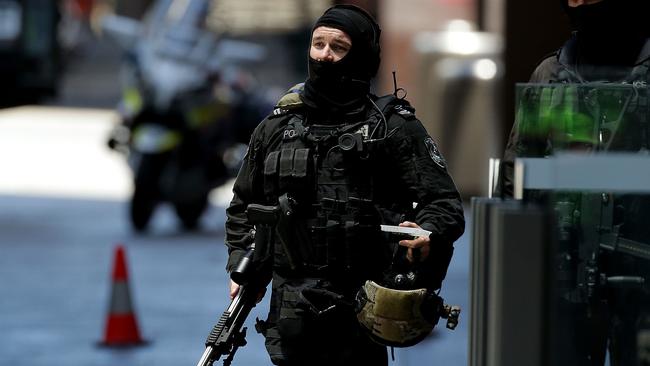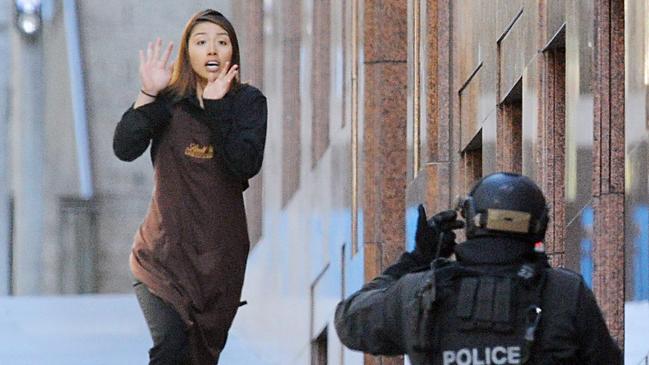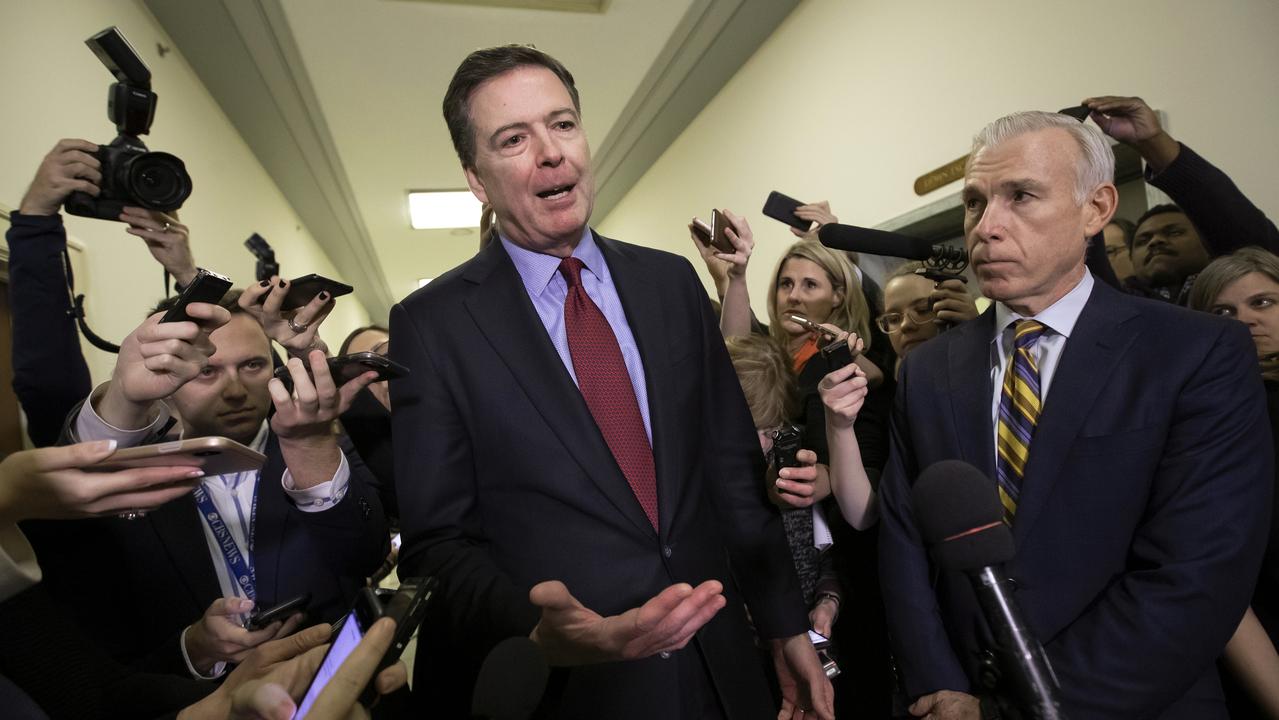Keeping terror at bay on the home front
Keeping Australia secure requires keen vigilance and closer co-ordination between government agencies.

There is no exit strategy when it comes to fighting domestic terrorism. The stabbing of three people at the Victoria railway station in Manchester, England, on New Year’s Eve and the subsequent detention of the attacker under Britain’s Mental Health Act could have played out so easily in Sydney or Melbourne.
This year, Australia’s police and intelligence services inevitably will be forced again to respond to groups or individuals radicalised by extremist Islamist ideology and planning violence in our streets.
As the threat changes, so too must Australia’s responses. In fact our intelligence, security and policing services have been going through radical and breathtakingly fast change for several years.
This has included the creation of the Home Affairs Department, involving the dramatic amalgamation of ASIO, the Australian Federal Police, the Australian Border Force, the immigration department and a host of smaller entities into a single organisation.
The intelligence agencies also have gone through a fundamental restructure, with the cyber specialists, the Australian Signals Directorate, “amicably” separating from the Department of Defence and a new Office of National Intelligence created to facilitate co-operation between culturally very different groups.
In recent years governments have passed, with bipartisan support, 13 packages of legislation enhancing police and intelligence powers, rewriting the law on counter-terrorism.
Beyond that, resources have been pumped into counter-espionage, with a particular focus on China in response to what ministers rightly say is unprecedented levels of spying and political interference in Australia.
Al-Qa’ida’s attacks in the US in 2001 shifted national priorities towards counter-terrorism so markedly that the counter-intelligence capabilities on which ASIO was founded atrophied. Rebuilding counter-intelligence for a new era of espionage will put yet more financial pressure on the intelligence community.
After years of reviews, reshaping, amalgamations and separations — all while police and the intelligence agencies shouldered a high operational workload — 2019 is a time when government should ensure that Australia’s counter-terrorism arrangements are best placed to handle emerging threats.
To date Labor has reserved its judgment about whether it will retain the Department of Home Affairs structure. It’s a massive organisation that carries co-ordinating responsibilities for counter-terrorism, cyber security, transnational serious and organised crime, and foreign interference.

Is there a point at which too much co-ordination of operational agencies becomes a bad thing? As Julia Gillard’s government showed, poorly designed public service departments and messy accountability structures damage clear policymaking.
After months of consideration, Malcolm Turnbull opted to create Home Affairs in 2017 after visiting its British counterpart. It has been assembled with great energy but with no obvious blueprint.
One area where Home Affairs has done an excellent job has been in strengthening the government’s approach to the security of critical infrastructure, an increasing problem when so much infrastructure is vulnerable to cyber tampering.
That said, the integration of ASIO and the AFP into Home Affairs is, at best, a work in progress. That both agencies still get their legal authority for key activities from the attorney-general points to an uncomfortable compromise.
Regardless of the election outcome in May, we should expect more changes in how Home Affairs works.
None of this wrangling over power and influence in domestic security should blur the operational focus of Australia’s typically high-performing federal police and intelligence agencies.
Our security agencies have an excellent record of disrupting terrorist plans. They identify 15 plots disrupted since 2014, most notably attempts to blow up an Etihad flight to Abu Dhabi with 400 passengers on board in July 2017 and a plan for multiple simultaneous attacks in Melbourne’s central business district in November 2017.
Inevitably, some plans will go undetected. Eight weeks ago, Hassan Khalif Shire Ali killed one person and injured two others in Melbourne’s Bourke Street before being shot by police and later dying in hospital.
It’s wickedly difficult to thwart the acts of unstable individuals but a growing part of the Australian counter-terrorism response must be to align the work of the security agencies with mental health and community service organisations.
A year ago we were bracing for the impact of terrorists returning from the Middle East after the fall of the so-called caliphate in Mosul. We know, for example, that 600 Indonesians have returned to their country after fighting in Iraq or Syria and that Islamic State-trained individuals were behind last May’s Surabaya bombings.
A pressing domestic Australian concern is what to do with the several hundred individuals in the country actively being monitored by the authorities as potential terrorism risks. Think of them as the terrorist A-team.
There is an even larger group of perhaps 400 to 500 people who are deemed to be at risk of radicalisation, but police and intelligence agencies lack the resources to closely monitor their activities. These are the B-team.

Shire Ali, for example, was known to the police as an Islamist extremist and his passport was confiscated in 2015 to prevent him from travelling to Syria. Even with that background, he was deemed not to be a threat and was not under active surveillance.
Man Haron Monis, the hostage taker at Sydney’s Lindt cafe in December 2014, was another example of a B-team terrorist, well known to the authorities, with a string of criminal charges, extremist views and mental instability, yet deemed not to be a threat.
An investigation will establish whether the Shire Ali case should have been handled differently. We should test how adequately we are handling the 200 individuals who have had passports cancelled since 2014 over concerns that they wanted to join terrorist organisations overseas. A significant number of individuals prevented from travelling to Iraq or Syria are not being consistently monitored.
We can be relatively confident that A-team extremists are under sufficient surveillance to make it very hard for them to participate in complex terror plots; however, there is a clear risk that B-team extremists have more scope to act as they draw less attention.
The Shire Ali case should force a discussion between state and federal governments about better ways of handling individuals who are “known to authorities” yet remain outside the web of active surveillance.
Just after Christmas, the NSW government released a counter-terrorism strategy setting out how at state level a more co-ordinated effort is being put into linking social services, healthcare, education, correctional services and policing efforts to manage individuals at risk of radicalisation. (Disclaimer: The Australian Strategic Policy Institute assisted the state government in developing this policy.)
It’s clear, for example, that some people who become radicalised have mental health issues that may have brought them into contact with state health facilities. Monis had been involuntarily hospitalised at Canterbury Hospital in 2010 after exhibiting bizarre and erratic behaviour in an Ashfield carpark. A sheik from Shire Ali’s mosque reportedly had described him as “not mentally fit”.
Although mental health professionals have confidentiality obligations to their patients, they can and do work with other agencies to manage individuals with extremist ideation.
In NSW alone, 42 individuals are in prison with convictions related to terrorism. Managing this group and others at risk of radicalisation in prison is another serious risk factor for state governments.
Like NSW, all other states also should make sure that all their agencies are able to pool their knowledge about interactions between them and people of concern. The more practices are shared and aligned, the better.
Although police forces are central to many aspects of counter-terrorism, almost every part of state and federal governments has a role to play in preventing people from radicalising, tracking those who take on extremist ideology, and working as a system to provide early warning if there is a risk of extremists turning violent.
If Australia is to remain a tolerant democracy there are necessary limits on how far we can take policing and surveillance, but we are not close to hitting those limits yet. The government was quite right late last year to push for parliamentary approval for a bill to provide controlled access for intelligence agencies to encrypted communications in support of counter-terrorist operations.
Labor, for its part, was right to call for amendments to produce better legislation.
ASIO head Duncan Lewis has told parliament’s bipartisan Joint Committee on Security and Intelligence: “The reality is that encryption is impacting ASIO’s technical intelligence coverage in at least nine out of every 10 of our priority cases.”
No government would overlook that assessment from ASIO’s boss. It goes directly to the agencies’ ability to detect terror plots.
Lewis has said that of the 15 plots disrupted since 2014, “our insights into around half of these investigations relied heavily on our ability to access the communications of would-be terrorists”.

That said, there is a pressing need at state and federal levels for governments to work more closely with the private sector. This includes the information technology sector and telcos, through to security guarding companies, private sector infrastructure, transport firms and even the management of notable structures such as the Sydney Opera House.
As my ASPI colleague Anthony Bergin has pointed out recently, there are more than 120,000 licensed security guards in Australia. Often these people will be the first to respond to a terrorist incident.
State and federal governments need to build the broadest possible network of individuals and organisations that share responsibility for countering terrorism.
What terrorism trends should we worry about in 2019? Beyond guarding against organisational churn in our police, security and intelligence agencies, I would highlight five factors to consider.
First, although the so-called caliphate has been destroyed, Islamic State has not been defeated. The “cyber-caliphate” is growing and, if anything, is a more pervasive global threat. Islamic State’s combat-hardened fighters have widely dispersed and will continue to train and recruit new supporters. This creates a focus for Islamist extremists in Australia. The prospect for more small-scale attacks by individuals is high.
Of even more concern is the potential for co-ordinated simultaneous attacks of the type that were planned for Melbourne on Christmas Day in 2016.
Second, as we have seen in Paris and Brussels, simultaneous attacks can potentially overwhelm our limited fast-response forces. The more we can harden our cities, particularly the Sydney and Melbourne CBDs, the harder it will be for terrorists to succeed with complex attack plans.
Third, we must prepare for new tactics. Islamic State used drones armed with small explosive charges in the battle for Mosul. Those tactics easily can be adopted in Australia.
Fourth, we must watch out for what some are calling the rise of right-wing violent extremism. This may not be as pressing an issue in Australia as it has become in some European countries, but we should be wary of a possible extremist backlash in response to Islamist extremism.
Finally, as demonstrated in the southern Philippines and Indonesia, Islamic State has an active presence in Southeast Asia. We must do what we can to help our neighbours in their counter-terrorism efforts, as much to protect our own interests as theirs.
Peter Jennings is executive director of the Australian Strategic Policy Institute and a former deputy secretary for strategy in the Defence Department.



To join the conversation, please log in. Don't have an account? Register
Join the conversation, you are commenting as Logout